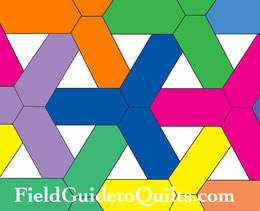The quilt top, which is unfinished, is made of wool and cotton and embellished with several shades of embroidery floss. The individual pieces were basted to paper templates made from miscellaneous papers, including old letters and order forms. We don't know who made it or where.
The embroidery is characteristic of a crazy quilt, although this quilt is does not have the irregular blocks that are a crazy-quilt hallmark.
The block design is particularly intriguing. We know of only three quilts that use this Y design. One showed up in a photo in a newspaper article in New York state in the 1970s. The other is in a "map" quilt in the collection of the American Museum of Folk Art in New York City. That quilt was part of Shelly Zegart's Why Quilts Matter, a documentary first aired on public broadcasting stations in 2011.
The arrangement of Y shapes and triangles is a continuous block. For now, we're calling that block by Hex Y & Tri. The name is the invention of Chris L., who brought the quilt to our attention.
At look at our graphic, above, suggests that it would also make a terrific border block. A block, though, can be replicated. The quilt is unique.
Photo courtesy of the Bowers Museum
As far as we know, the block that makes up this quilt has no name other than the one given it by Chris L, "Hex Y & Tri." If you have a quilt with this design, please let us know!
Who made my quilt?
Here are a few ways to find out more about a remarkable quilt, especially if you can guess where the quilt was made.
• Find out the name of the family whose estate was sold by contacting the company that ran the sale.
• Check the U.S. census records to find out who lived in the house when the quilt was made. The 1890 census was destroyed in a fire, but the others (up to the 1940 census) are available on line.
• Ask the local historical society and/or museum. They'll know the names of families who l ived in the area for a long time. There may be relatives still living nearby who could identify the quilters. The historical society may even have needlework by the same quilters among their holdings.
• Look into past newspaper articles on county fair winners. If a quilter made one beautiful quilt, she may have made another to enter in the fair.
If you don't know anything at all about the quilt:
• Contact your nearest quilt museum to ask about quilt identification days. The International Quilt Study Group schedules several such days a year. The catch: They're in Lincoln, Nebraska. For information, go to: http://www.quiltstudy.org/visit/ or publicprograms/quiltidday.html
• Ask a quilt appraiser. You may not get the names you were looking for, but you'll certainly find out more. If you can't find recommendations locally, look for an appraiser certified by the American Quilter's Society of Paducah, Kentucky.
|
 Crazy Quilts
Crazy Quilts

 Chris L. fell in love with this design after she saw it made up as a crazy quilt in the Bowers Museum in Santa Ana, California. To see the Bowers quilt top, click on the photograph.
Chris L. fell in love with this design after she saw it made up as a crazy quilt in the Bowers Museum in Santa Ana, California. To see the Bowers quilt top, click on the photograph.
